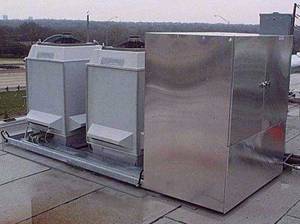

|
(512) 704-8200 |

|
To learn more on commercial retro fitting RTU’s and Refrigeration visit: Thermco Energy Systems |

|
Sub-cooling any Roof Top Refrigeration increases the overall performance of the interior cooler systems efficiency by reducing compressor power. With most all medium box style buildings with in-store coolers have the refrigeration mounted on the roof exposed to the elements and Subcooling will decreases the amount of energy consumption and save real money. We have Evaporative condensing cooling or evaporative subcooling Retro fit designs to handle all existing small and large refrigerant / refrigeration layouts. |
|
We offer complete skid mounted packages for quick and easy retrofit conversions. |

|
Our evaporative fluid cooler tower is a closed circuit tower design that is lightweight enough to be installed on a roof with out structural upgrades. The unique design of the model called “Demand-Buster” system allows one fluid cooler to subcool a number of refrigerant - refrigeration systems |
|
Before we discuss subcooling and super heating, it is essential to understand what refrigeration is. Refrigeration is the extraction of heat, or the transmission of heat by mechanical methods, from one location to another. Subcooling in refrigeration implies cooling the refrigerant in liquid state, at uniform pressure, to a temperature that is less than the saturation temperature, which corresponds to condenser pressure. |
|
Condensers are known and widely used in cooling devices of any kind. The condensers gaseous refrigerant condensed to liquid refrigerant and then supplied to the expansion device and the evaporator downstream of the condenser. When a condenser is followed by a sub cooling unit in order to cool the liquid refrigerant even further before feeding it to the expansion device and the evaporator. This increases the efficiency of the vapor compression cycle. Reduces energy consumption and increases performance. |
|
In most cases the refrigeration condensers are mounted in a cabinet without any cooling, trapping the hot air causing the compressors to consume even more energy to operate. |

|
HVAC |
|
Call or Submit a Request for Pricing |
|
Call or Submit a Request for Pricing |
